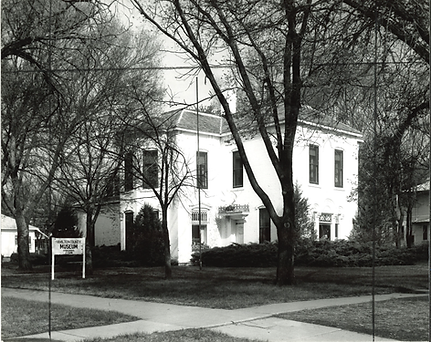Acerca de
ABOUT
THE PLAINSMAN MUSEUM
"We are under lasting obligations to our pioneer men and women for the social, economic and agricultural development that we now enjoy... The more we learn of our early history the more we will appreciate our heritage for which we wish to pay our humble respect to Hamilton County Pioneers."
~ Joe E. Gunnerson, Hamilton County Museum Founder, 1967

Our Mission
"The Plainsman Museum is a not-for-profit institution, which focuses on the time from 1860-1950, that collects, preserves, illustrates, and works to establish the History of Hamilton County, Nebraska through education, exhibits, research, and maintenance of relevant archives and collections."
~ Mission Statement of the Plainsman Museum
July 13, 2000
President of the Board of Directors: Wesley Huenefeld
Museum Director: Sarah M. Polak

The beginnings of the Plainsman Museum trace back to September 1, 1935 – the day the Hamilton County Historical Society was officially formed under the leadership of then-President Frank E. Edgerton and then-Secretary Joe. E Gunnerson. For many years before that, there was a desire in the community to set up a space designated as the local museum. Now the Historical Society would strive to make this dream a reality with the establishment of the Hamilton County Museum, first housed in the basement of the county courthouse from 1935 – 1943. The museum was first curated by Joe E. Gunnerson.
^ Joe E. Gunnerson
It was in 1943 that the museum collection exceeded the space allotted to it in the county courthouse, and thus was moved to a historical residence in town. At the time, it was known as the T. E. Williams residence. In present-day, many local residents know the property as the Otto House. The museum’s collection remained on display in the house until, again, the volume of items in the collection exceeded the available space. The museum very much needed its own larger facility in order to house the archives and properly display its artifacts.

^ The T. E. Williams residence (a.k.a. the Otto House) after being converted into the Hamilton County Museum. c. 1940's

^ At the site of the future Plainsman Museum. In photo (L to R):
Jack O'Brien, President Wesley Huenefeld and Albert Oswald.

In July of 1969, under the leadership of then-President Wesley Huenefeld, the Hamilton County Historical Society was reorganized, and they arranged to purchase four acres of land along Highway 14 that would become the museum’s campus. Costs for purchasing the land and constructing the museum building were estimated at first to be around $100,000, and fund drives began in October of 1972. By December of that year, the Historical Society had raised enough money with the help of the community to cover the purchase of the land. In September of 1973, ground was broken to begin construction on the museum building itself by Geer Milkus Construction of Grand Island (for a bid of $191,945). In August of 1975, volunteers from the Aurora Chamber of Commerce and others began moving the museum collection into the new building, and in November of that year volunteers began preparing exhibits for display.
^ Museum Manager Gwen Allen stands under the new sign for the Plainsman Museum. Aurora News-Register, April 15, 1982
On July 4, 1976, the Plainsman Museum was officially dedicated and opened to the public for the very first time, and has remained the home for Hamilton County’s history for over forty-five years. Since its opening, the museum has added two additional acres of land to its campus, an agricultural building (opened July 4, 1986 as part of the Plainsman’s 10th anniversary), a one-room schoolhouse (donated in 1986), Gen. Delevan and Lana Bates’ historical Victorian home (moved to museum grounds in 1998), the Grieser Blacksmith Shop (moved to museum grounds in the early 2000's), and a Burlington Northern caboose (donated in 2004). It is within these buildings and exhibits that the Plainsman Museum currently houses over 50,000 artifacts.

